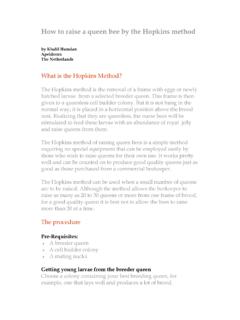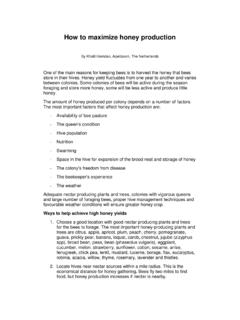Transcription of Equalization of Bee Colonies Strength - Country …
1 Equalization of Bee Colonies Strength khalil hamdan , apeldoorn , The netherlands The aim of equalizing bee Colonies is to make weak and strong Colonies in the apiary of a similar Strength before the nectar flow. We do this by boosting a weak colony by giving it either some brood or extra bees from a strong colony. There are many factors that may contribute to weakening of a colony. However, weak Colonies are slow to build up, do not develop into strong Colonies if they are left alone, have a smaller number of foraging bees, and produce little honey even if a good nectar flow exists. They are vulnerable to robbing by robber bees from stronger Colonies . Strengthening those that are not too weak will speed up their growth a great deal and reduce the chances that the strong ones will swarm. Colony Strength The population of a bee colony is not static and varies with the season of the year.
2 A colony of bees will have a low population, approximately 10,000 to 15,000 early in the season (January and February), and will grow to 30,000 to 60,000 bees in the peak breeding season (spring and midsummer). In early spring, a colony with 5 -7 frames covered with bees and at least 4 frames of brood is a strong colony, where one with 3 or 4 frames covered with bee is weak. On the other hand, in the peak breeding season a strong colony will have 10 -15 frames covered with bees and minimally six combs with brood, and have many foragers flying in and out as well as honey and pollen stores, whilst a colony with 5 -7 frames covered with bees, with 3 frames of small brood would be weak. The value of Colonies with larger populations can be illustrated by the amount of honey produced by Colonies of different population. One colony of 30,000 bees produces 1 times as much honey as of two Colonies with 15,000 bees each.
3 One colony of 45,000 bees produces 1 times as much honey as three Colonies with 15,000 bees each. One colony of 60,000 bees produces 1 times as much honey as four Colonies with 15,000 bees each. Strong bee colony with large population. Plenty of bees cover the top of the combs. Photo credit: MAAREC (Mid-Atlantic Apiculture Research and Extension Consortium) and Dave Hackenberg (photographer) In a strong hive, plenty of bees can be seen between the frames Photo credit: The advantages of the Equalization It makes Colonies more or less equal in Strength for the honey flow It boosts weak Colonies and does not affect the contributing Colonies since strong Colonies recover quickly It is an effective method of preventing swarming by reducing congestion in more populous hives It can result in a greater honey yield It makes all Colonies productive It minimizes robbing in the apiary Disadvantage Equalizing can transmit disease and mites between Colonies in the apiary.
4 Can cause chilled brood if it is not done carefully Great care should be taken not to distribute brood combs and bees from sickly Colonies . Always check the Colonies for signs of disease before equalizing. Never equalize a weak colony caused by disease. Take care not to stretch the brood too far in weak Colonies , as there may bee too small a population of bees available to keep brood warm at night. Starting the process Equalizing is commonly done in the spring during the buildup period, three to six weeks ahead of the blooming period (nectar flow), and it is done when there is a need in the weak Colonies . Only the very strong Colonies with a large amount of brood and large bees population are equalized. Weak Colonies that are due to an old or failing queen are not worth equalizing. In cases like this it is better to be unite or requeen as described below.
5 Extremely weak Colonies with a low bee population and a few combs of small brood (10 -12 cm in diameter) are not worth keeping. The best thing to do is to integrate 2 or 3of the weakest Colonies with a few combs (2 frames of bees) into one box and unite this box with moderately strong colony before the honey flow. Methods of Equalization There are many ways to strengthen weakened Colonies . Here is how: Transferring frames of sealed brood from a strong to a weak colony. Surplus frames of sealed brood with adhering bees are taken from a strong colony and given to a weak colony. You should never take brood away from a weak colony. Frames removed from the donating colony are replaced with drawn combs. If drawn frames are unavailable then frames of foundation are used. A strong colony will rapidly draw out fresh foundation and the queen will soon be laying eggs in it.
6 Give weak Colonies one frame of brood at a time, so that bees can cover the entire brood. Insert the frame with brood in the middle where the brood is better nurtured. The number of frames of brood to be given depends upon how weak Colonies are. If they need two or more frames of brood at one time, then you can find more than one donating colony. Be sure that any comb being moved from the strong colony does not have the queen on it. Add frames with good quality brood a frame with the largest surface of brood (more than a half of frame) on both sides. Do not add unsealed brood. Very little will be gained by adding unsealed brood to a weak colony as there may be too small a number of young bees to care for the extra brood, and you want the sealed brood to hatch as soon as possible to add to the population of young bees. Unsealed brood requires maximum care from the colony, whereas sealed brood requires minimum care.
7 The sealed brood will emerge, strengthen the bees in the weak colony and will start brood rearing. In 3 days they start to feed the oldest larvae, and in around 6 days they feed the youngest larvae. Newly emerged bees become foragers about three weeks after they emerge. They may forage up to three weeks. A good quality brood frame. The frame has two thirds of capped brood on both sides Photo credit: WV beekeeper - Cass Cohenour It is important to check whether a colony is developing well. You have to go back and look in about 1-2 weeks to see how things are going. Whether or not they need another infusion. If the first attempt did not accomplish much, there is some other problems that needs to be addressed ( disease, varroa, a bad queen, etc.) Weak Colonies being equalized with brood are given unsealed honey frames or fed with supplemental feed as needed during the Equalization .
8 This stimulates Colonies to develop into strong ones. Shaking frames of young bees taken from populous colony into the weak hive. Surplus young bees from the largest adult population are shaken off. The equalizing can be carried out 2 - 3 weeks prior to the honey flows. This helps increasing the adult bee population. Make sure that the queen is not transferred with the bees when shaking out extra bees. Tip: You can shake on to a queen excluder and capture any queen you mistakenly shook. Exchanging positions of weak Colonies with that of strong ones. Swapping the position of Colonies is an easy practice to increase the number of foragers in the weaker colony and alleviate the congestion in the stronger one. A weak colony is removed to the spot occupied by a strong hive and the strong hive is moved to the former position of the weak colony.
9 This is usually done when the foraging bees from a strong colony are out during the middle of the day. When the foragers from the strong colony return to the hive they will enter the weak colony now on this spot. Bees flying back laden with nectar or pollen are welcome and accepted into any colony without fighting. Swapping Hive Positions C A B C D 1) Before swapping, hive A & D are very strong. Hive B is medium and hive C is weak. Hive A swapped with C, and B with D. C D A B 2) After swapping, hive B & C become a lot stronger, hive A & D become a little weaker. Adding a queenless package bees two or three weeks prior to honey flow.
10 Read below how to unite two groups of bees by using the newspaper uniting method. Uniting Honey bees by the newspaper method Image credit: Uniting honey bees by using a sheet of newspaper is the most common method of uniting two different Colonies of bees together. The sheet of the newspaper separates the two Colonies and allows a slow mingling of the odours of the two Colonies , so bees integrate with minimum fighting. A queenless or weak colony and packaged bees may be united with another by this method. The weaker colony is put on top of the stronger one. If both Colonies are queenright, the least desirable or the older queen is removed before uniting. The process is carried in the evening when the bees are not flying as follows: - Cull the old or failing queen first. - Open the hive with the queenright or strong colony.

